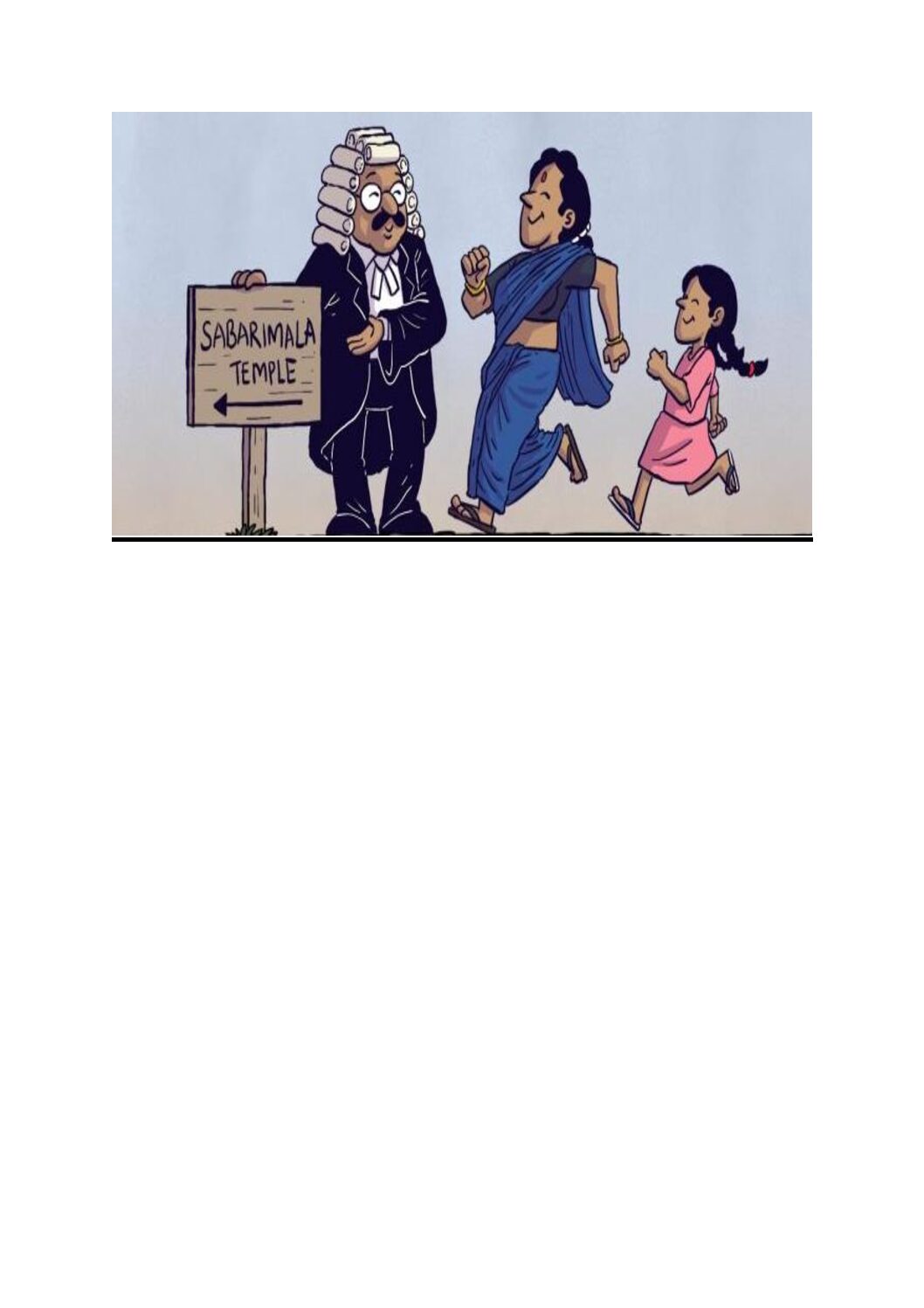Article review
By- Aratrika Ghosh
The Sabarimala Judgment: Reformative and Disruptive – The …https://www.thehinducentre.com
REVIEW OF THE ARTICLE WRITTEN BY ELIZABETH SESHADRI, PRACTISING ADVOCATE OF MADRAS HIGH COURT, ON THE JUDGMENT DELIVERED BY THE HON’BLE SUPRME COURT ON THE ISSUE OF RESTRICTION ON ENTRY IN SABARIMALA TEMPLE
In the given article; “Sabarimala judgment: reformative and disruptive”, the author Elizabeth Seshadri, a practicing Advocate of Madras High Court, reviewed and analysed the judgment delivered by the Honourable Supreme Court of India. In the course of this context, she emphasizes the manner Indian jurisprudence is evolving on numerous instances of Religious and Spiritual Rights. She has additionally mentioned the underlying causes of abstaining women of certain ages to participate in some religious practices.
Seshadri critically analysed the scenery of this case at the onset by touching on Arunachalam Muruganantham, on whom the movie industry motion picture ‘Pad Man’ depends on. He said, “Women in Rural India have the strangest beliefs surrounding the monthly period.” Hence, the author considers the judgment by the Supreme Court in Indian Young Lawyers Association v. State of Kerala, additionally referred to as ‘Sabarimala judgment’, to be helpful and to some extent reformative.
This case budded from a petition filed by a Registered Association of young Lawyers, challenging the Constitutional validity of Rule 3(b) of the Kerala Hindu Places of Public Worship (Authorisation of Entry) Rules, 1965, which restricts the entry of girls into the Sabarimala temple during their menstrual period. In 1955 that Rules were framed under the Kerala Hindu Places of Public Worship (Authorisation of Entry) Act, 1965. This Act was enacted to make provisions for the entry of all classes and sections of Hindus into places of public worship.
The Travancore Devaswom Board issued two notifications expressed that the ages between 10 and 55 were to be excluded, (during menstrual period it had been scrutinized and confirmed by the Kerala Tribunal that in the following ages between the age of ten and fifty Five were being excluded. The case before the Supreme Court was that Rule3(b) was beyond the powers of Section 3 of the Act which women of any age could not be excluded from entry into the temple.
According to Seshadri, the abundance of Indian jurisprudence on faith has turned around which constitutes a vital religious issue. The Religious bodies have objected to the government’s action arguing that the activity is completely spiritual and not secular. So as to induce the special rights under Article 26 of the Constitution of India, most cases concerned an effort by the groups to point out themselves as a definite religious denomination. An equivalent was tried within the Sabarimala case too. Though the dissident judgment of Justice Malhotra gave the Ayyappans denominational standing, the bulk judgment control that the Ayyappans were not separated religious denomination, however, were Hindus only.
Thereafter, it had been for the Court to seek out if the issue of excluding girls of a precise age from entry into Sabarimala was a vital feature of Hinduism or not. It is attention-grabbing to check the evolution of Indian jurisprudence simply by making an attempt by Indian Courts to tell apart between what is a “matter of Religion” and what is not, in many cases over the decades. This exercise is additionally fascinating so that readers perceive that the jurisprudence applied by the Supreme Court within the Sabarimala case is according to the principles that have evolved over decades and in relevance all religions uniformly.
The author cited several examples, like once the Madras Hindu Religious and Charitable Endowments Act, 1951 was enacted to solely empower a statutory commissioner to intervene if they had ‘reason to believe that a religious establishment was mismanaging funds. This Act was challenged by the Mathadhipathi of the Shirur Mutt, who claimed that the law interfered together with his right to manage the spiritual affairs of the Mutt. The Supreme Court examined the question, “Where is the line to be drawn between what are matters of Religion and what are not?” The Court held: “What constitutes the essential part of a Religion is primarily to be ascertained with reference to the doctrines of that religion itself.” Similarly, the Qureshi Muslims of Bihar petitioned the Supreme Court difficult the ban on cow slaughter on the bottom that it infringed on their basic right to faith as they were compelled by their faith to sacrifice cows on Bakrid. The Court, wanting into the Muslim religious text, found that there was no proof to point out that the sacrifice of cows on Bakrid was a vital follow for the Qureshi Muslims. The author mentioned several cases as samples of however Indian jurisprudence evolved on this delicate issue.
The author found it noteworthy, how the fanciful arguments narrated as stories capture our fancy, get passed on, new beliefs or superstitions are created. She additionally gave her opinion regarding the important reason of those superstitious notions regarding the flow and cited the practice of not permitting girls into temples as a follow of untouchability. The author expressed at the conclusion of the Article that despite all the taboos relating to the flow of ladies, they need the correct to steer life with dignity, as secured by Article 21 of the constitution. She additionally represented the Sabarimala Temple because of the image of all religions, because the Muslims and Christians in Kerala also follow Lord Ayyappan, the presiding immortal. She thinks that in keeping with Article 51A of the constitution, it is the duty of each subject to develop the spirit of
reformation.
CONCLUSION
After reading the Article, we tend to understand the scenery of Sabarimala judgment, the evolution of Indian jurisprudence within the matters of religious problems, taboos still followed by the places of worships relating to the flow of ladies. It is really an informative one and it is very dynamic and helpful for a law student to browse the article.
Bibliography:-
i)https://www.scobserver.in/court-case/sabrimala-temple-entry-case/plain-english-summary-of-judgment-ee5ae148-9597-479f-84d7-35d398ed5e68
ii) https://indiankanoon.org/doc/163639357/


